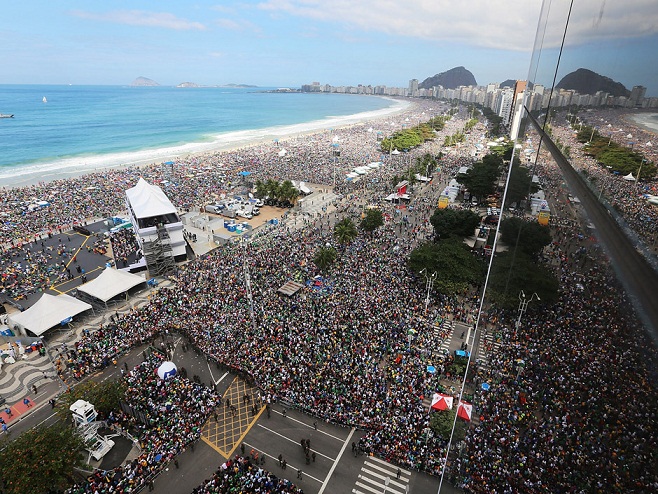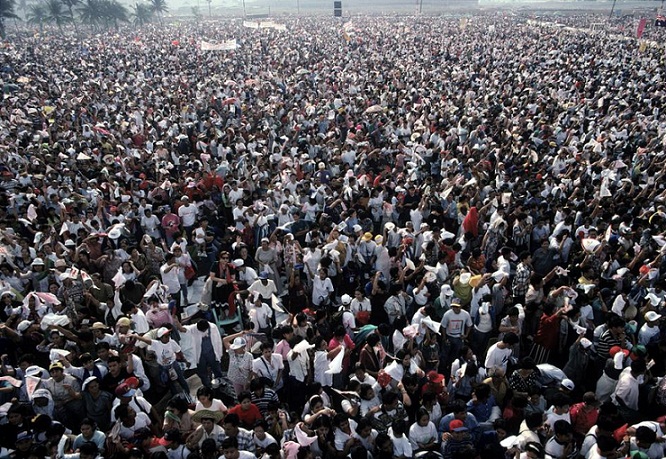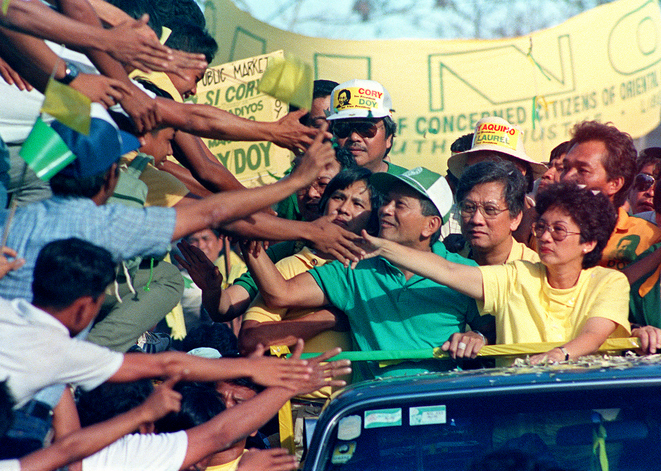
There is more to the size of the crowd than just numbers.
Associated Press ran a story of Pope Francis July 28 Copacabana mass that concluded his highly successful visit in Brazil. A native of Argentina, the Brazil visit that capped the 2014 World Youth day, was his first in Latin America.
Press reports, quoting official figures by Vatican, said the Copacabana mass was attended by three million.
The reports said, in the history of Papal visits, only the five million Philippine crowds at the Rizal park mass of Pope John Paul II in 1995 topped the number of assembled Catholics at the Copacabana beach.
(Although the Rizal Park crowd is no doubt mammoth, there are some technical people who cast doubt on the five million estimate as that would have meant people standing close to each other with hardly a breathing space on the streets up to Pasay City. But it still feels good that the Philippine’s record in welcoming the Pope has remained unmatched.)

AP, however, raised the impossibility of the three million figure. “By the Vatican’s count, the crowd density throughout the entire area would have been 7.4 people per square meter, which wouldn’t allow for movement of any kind, let alone the jumping, arm waving, singing and dancing seen at the papal events. Video and photos of the crowd also showed that while it was packed close to the gigantic altar built on Copacabana beach, the faithful thinned out along the 4-kilometer long beach.”
AP sought the opinion of Datafolha, one of Brazil’s top polling and statistic firms, which put the size of the July 28 crowd at between 1.2 million and 1.5 million people.
AP quoted Clark McPhail, an emeritus professor of sociology at the University of Illinois who has studied crowd counts for four decades as saying “It’s an old, old story that organizations, whether political radicals or the Vatican, always over-guesstimate the size of turnout, they want their event to look as good as possible.”
One is not surprised to get bloated figures from political organizations but does welcome that from a religious institution that preaches honesty.
AP said “A big crowd estimate would surely be a boon to the pontiff’s supporters, who would argue that the multitudes gave him a popular mandate to battle entrenched Vatican officials who don’t look kindly upon Francis’ drive to reform the church’s opaque and scandal-ridden bureaucracy.”
For Brazil, AP said, “ The bloated crowd figure also provided cover for city officials in Rio, where logistical problems seen during the papal visit brought into question the city’s ability to host 2014 World Cup group stage and championship matches, not to mention the 2016 Olympics.
“Those attending the papal events complained about the city’s woeful public transport system, a lack of affordable hotel rooms, the need for public toilets and a local services industry not able to meet demands for things as simple as lunch. A miraculously high crowd count would make all that more understandable and give local officials breathing room.”
Media, of course, should have done better than take unquestioningly the figures fed by the host country and Vatican.
Usually reporters use the Jacob’s formula in estimating crowds which is, in a loose crowd, where people are at an arm’s length of each other, one person in an area of about 10 square feet. In a tighter crowd, it’s about half that, or 5 square feet. In a packed crowd, it’s more like 2.5 square feet.
The formula was originated by Herbert A. Jacobs, a journalist for the Milwaukee Journal and later a professor of journalism at the University of California, Berkeley who covered the protest rallies during the Vietnam War in the 60s.
The size of the crowd is important in rallies during political campaigns because to candidates, it’s a reflection of their voters’ pull. They need an impressive shot of their rallies to create the much-desired bandwagon.

During the 1986 snap election campaign between Ferdinand Marcos and Cory Aquino, a reporter of the government-owned Philippine News Agency was in a dilemma, how to save his stories of huge crowd coming to Aquino’s rallies from being killed by his editors.
There were no internet nor fax machines at that time and we were filing our stories from the provinces by RCPI or Clavecilla phones. I was standing in line, next to him, for the phone and I could hear the story he was dictating. I noticed that his estimate of the crowd size was more than double the size that we saw and I asked him why after he put down the phone.
He explained: “My editors will surely cut into half the size of the crowd in my story. Our readers will get the correct report.”
A smart reporter.
Reporters usually rely on police estimates.
Police estimate, on the other hand, depends on their bias. If pro-government it’s usually bloated. If anti-government, the figure is downgraded.
I still remember Pope John Paul II’s last day in Manila. We saw on TV that from Luneta, all the way to NAIA, Roxas Blvd. was overflowing with people so much that people coming from Taft Ave. hoping to cut through any of the perpendicular streets that would take them to Roxas Blvd. got stuck in those streets, traffic was a standstill and only the LRT was moving. Taft Ave. and those streets were filled with parked buses, vans, jeepneys, trucks, etc that came from all over Luzon for this final sendoff of the Pope. I left my car at my Bicutan house and took the bus going to the office which was a few blocks away from the airport. I called our guard before I left home and I was told the streets were impassable due to the crowds.
As our bus was stuck in traffic at the Malibay intersection, police cars with blaring sirens were approaching from the opposite direction and tailing them was the Pope Mobile. I was in luck, I never expected to see the Pope in person and here he is, his convoy avoiding the huge crowds in Baclaran, Coastal Road, MIA Road, and Imelda Ave. It saved them at least an hour of weaving through the people in the streets. And cut the risk of any assassination attempt on the Pope.
Remember that by this time, Oplan Bojinka had already been busted by Manila Police. The plan called for the assassination of the Pope along his motorcade’s route, while those of Bill Clinton and FVR were canceled. The plan would later capitalize on the confusion as the aftermath of the Pope’s assassination and proceed to bomb several commercial airlines and the final blow that would be the crashing of a bomb-filled aircraft into the CIA HQ in Fairfax, Virginia flown by captured terrorist Murad. Murad was caught when he returned to Josefa Apartments to retrieve Ramzi Yousef’s laptop, fortunately, the firemen and cops have remained there to guard the fire scene until a judge signed the search warrant.
While the Pope was largely credited for the downfall of the communist regimes in Eastern Europe, a new enemy was emerging in the Middle East. It was awesome to even continue with the trip knowing that an assassination plot was ongoing and that the risk was not over until John Paul II was back in Vatican. This, I think, was what endeared him more to Filipinos, the adoration and respect manifested by the millions who showed up wherever he was appearing.
Now Vatican has finally realized how important it is to recognize the efforts of countries like the Philippines and Southern Americas to keep the Catholic faithful’s growth in numbers while it is dwindling in Europe. Pretty soon we will have our third saint – a Manila-born martyr with Spanish parents who will be beatified in a few months.
tongue, we were in Taft Avenue then.
Who will be our third saint?
After his beatification in October, he will be known as Blessed Jose Maria de Manila and after canonization, as St. Jose Maria de Manila. His father was the last Spanish mayor of Manila, Don Eugenio Saz-Orozco. He was among the 500 martyrs persecuted by anarchists and Marxists in Spain in the 19930s 32 of which are waiting to be beatified.
Further reading: http://www.manilatimes.net/filipino-priest-martyred-in-spain-to-be-beatified/20874/
Tenkyu, tongue!